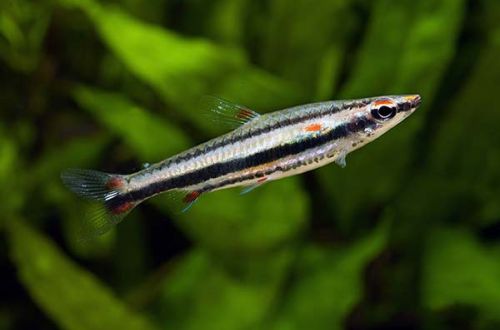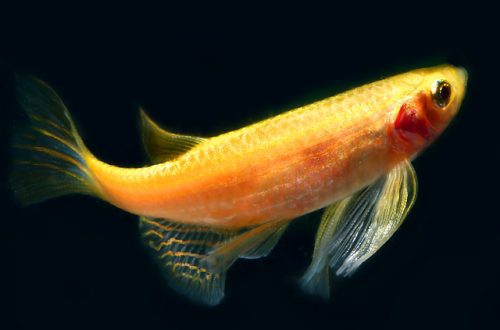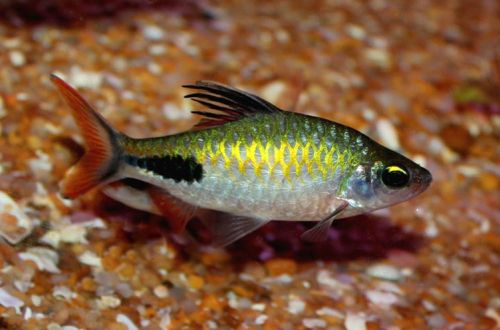
Nannostomus three-lane
Nannostomus trifasciatus, scientific name Nannostomus trifasciatus, belongs to the Lebiasinidae family. A popular well known aquarium fish. Easy to keep and breed, compatible with other freshwater species. Can be considered as a first fish for beginner aquarists.

Contents
Habitat
Comes from South America. It is widely distributed in the western part of the Amazon basin in Brazil, Peru, Colombia and Bolivia, as well as in numerous small river systems in Guyana and Suriname. The fish inhabits streams and rivers with a slow flow, flowing among tropical forests, swamps, floodplain lakes, prefers regions with dense aquatic vegetation.
Brief information:
- The volume of the aquarium – from 60 liters.
- Temperature – 22-28°C
- Value pH — 4.0–7.5
- Water hardness – 1–12 dGH
- Substrate type – any
- Lighting – subdued, moderate
- Brackish water – no
- Water movement – little or no
- The size of the fish is about 3 cm.
- Food – any food
- Temperament – peaceful
- Content in a group of 10 individuals
Description
Adult individuals reach a length of about 3 cm. Sexual dimorphism is weakly expressed, males practically do not differ from females. Depending on the specific region of origin, three-banded Nannostomus may vary in color. For example, representatives of the Peruvian rivers have a simple silver color with characteristic black stripes stretching from head to tail. Whereas, Brazilian forms have red markings all over their bodies. Previously, due to such differences, they even belonged to different species.
Food
Undemanding to the diet, will accept most foods of a suitable size intended for aquarium fish. The basis of the diet can be dry foods in the form of flakes, granules, as well as live or frozen brine shrimp, daphnia, small bloodworms.
Maintenance and care, arrangement of the aquarium
The optimal size of an aquarium for a flock of 10 fish starts from 60–70 liters. The design uses dark soft soil, a lot of aquatic plants, including floating ones, driftwood of variable size and other natural decor. All this will help to recreate an environment reminiscent of a natural habitat.
A useful addition will be the leaves of some trees, which are placed at the bottom. When they decompose, processes similar to those that occur in nature will occur – tannins will be released, giving the water the necessary chemical composition, and at the same time coloring it with a slightly brown color. The latter is normal and should not cause concern. About all this in more detail in a separate article “The leaves of which trees can be added to the aquarium.”
It is worth noting that the leaves will serve as an excellent environment for the development of beneficial microorganisms, such as shoe ciliates – a valuable secondary food source for fry.
For many years Nannostomus tristripes have been successfully kept in home aquaria and during this time have managed to adapt to life in a slightly different environment than their wild relatives. This is manifested in the ability to tolerate a relatively wide range of hydrochemical values. However, slightly acidic water of low carbonate hardness is considered comfortable. It is important to ensure stable water conditions and prevent the accumulation of organic waste.
Behavior and Compatibility
Relatively peaceful fish, although males tend to compete with each other for the attention of females. The skirmishes between them are sometimes quite violent and can even lead to injuries. However, the likelihood of this occurring in a large aquarium will be extremely low. In the daytime, the fish stay alone, and at dusk they gather in a flock. It is recommended to maintain a group size of at least 10 individuals of both sexes. Compatible with other non-aggressive species of comparable size.
Breeding / breeding
Successful cases of breeding are not rare. In favorable conditions, the fish will spawn regularly. In the artificial environment of aquariums, seasonality of reproduction is not traced. The larger the flock of fish, the more spawning occurs. Females scatter eggs near the bottom, and males fertilize them. There is no parental care for offspring. In addition, adult fish, on occasion, will definitely feast on their own fry, therefore, to protect them, the eggs are moved to a separate tank with identical water conditions. The incubation period lasts about 3 days. In the first days of life, fry need microscopic food, such as shoe ciliates, or specialized powdered foods.
Fish diseases
Diseases inherent in this particular species of fish were not noted. When kept in suitable conditions (high water quality, balanced diet, non-conflict neighbors, etc.), health problems are not observed. The most common cause of disease is the deterioration of conditions leading to immune suppression, which makes the fish susceptible to infections that are invariably present in the surrounding area. When the first signs of an illness are detected (lethargy, exhaustion, refusal of food, lowered fins, etc.), it is necessary to immediately check the main parameters of the water. Often, the restoration of acceptable living conditions contributes to self-healing, but if the fish is too weak or has received obvious damage, medical treatment will be required. For more information on symptoms and treatments, see the Aquarium Fish Diseases section.





